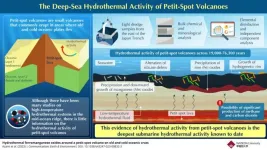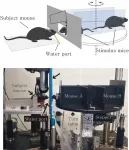(Press-News.org) In crisis, the nucleus calls antioxidant enzymes to the rescue. The nucleus being metabolically active is a profound paradigm shift with implications for cancer research.
Summary points
The human nucleus is metabolically active, according to the findings of a new study in Molecular Systems Biology by researchers at the CRG in Barcelona and CeMM/Medical University of Vienna,
In a state of crisis, such as widespread DNA damage, the nucleus protects itself by appropriates mitochondrial machinery to carry out urgent repairs that threaten the genome’s integrity
The findings represent a paradigm shift because the nucleus has been historically considered to be metabolically inert, importing all its needs through supply chains in the cytoplasm
Cancer hijacks cellular metabolism for unfettered growth. The findings can help guide future lines of cancer research by offering new clues to overcome drug resistance and eventually the design of new treatments
Main text
A typical human cell is metabolically active, roaring with chemical reactions that convert nutrients into energy and useful products that sustain life. These reactions also create reactive oxygen species, dangerous by-products like hydrogen peroxide which damage the building blocks of DNA in the same way oxygen and water corrode metal and form rust. Just how buildings collapse from the cumulative effect of rust, reactive oxygen species threatens a genome’s integrity.
Cells are thought to delicately balance their energy needs and avoid damaging DNA by containing metabolic activity outside the nucleus and within the cytoplasm and mitochondria. Antioxidant enzymes are deployed to mop up reactive oxygen species at their source before they reach DNA, a defensive strategy that protects the roughly 3 billion nucleotides from suffering potentially catastrophic mutations. If DNA damage occurs anyway, cells pause momentarily and carry out repairs, synthesising new building blocks and filling in the gaps.
Despite the central role of cellular metabolism in maintaining genome integrity, there has been no systematic, unbiased study on how metabolic perturbations affect the DNA damage and repair process. This is particularly important for diseases like cancer, characterised by their ability to hijack metabolic processes for unfettered growth.
A research team led by Sara Sdelci at the Centre for Genomic Regulation (CRG) in Barcelona and Joanna Loizou at the CeMM Research Center for Molecular Medicine of the Austrian Academy of Sciences in Vienna and the Medical University of Vienna addressed this challenge by carrying out various experiments to identify which metabolic enzymes and processes are essential for a cell’s DNA damage response. The findings are published today in the journal Molecular Systems Biology.
The researchers experimentally induced DNA damage in human cell lines using a common chemotherapy medication known as etoposide. Etoposide works by breaking DNA strands and blocking an enzyme which helps repair the damage. Surprisingly, inducing DNA damage resulted in reactive oxygen species being generated and accumulating inside the nucleus. The researchers observed that cellular respiratory enzymes, a major source of reactive oxygen species, relocated from the mitochondria to the nucleus in response to DNA damage.
The findings represent a paradigm shift in cellular biology because it suggests the nucleus is metabolically active. “Where there’s smoke there’s fire, and where there’s reactive oxygen species there are metabolic enzymes at work. Historically, we’ve thought of the nucleus as a metabolically inert organelle that imports all its needs from the cytoplasm, but our study demonstrates that another type of metabolism exists in cells and is found in the nucleus,” says Dr. Sara Sdelci, corresponding author of the study and Group Leader at the Centre for Genomic Regulation.
The researchers also used CRISPR-Cas9 to identify all the metabolic genes that were important for cell survival in this scenario. These experiments revealed that cells order the enzyme PRDX1, an antioxidant enzyme also normally found in mitochondria, to travel to the nucleus and scavenge reactive oxygen species present to prevent further damage. PRDX1 was also found to repair the damage by regulating the cellular availability of aspartate, a raw material that is critical for synthesising nucleotides, the building blocks of DNA.
“PRDX1 is like a robotic pool cleaner. Cells are known to use it to keep their insides ‘clean’ and prevent the accumulation of reactive oxygen species, but never before at the nuclear level. This is evidence that, in a state of crisis, the nucleus responds by appropriating mitochondrial machinery and establishes an emergency rapid-industrialisation policy,” says Dr. Sdelci.
The findings can guide future lines of cancer research. Some anti-cancer drugs, such as etoposide used in this study, kill tumour cells by damaging their DNA and inhibiting the repair process. If enough damage accumulates, the cancer cell initiates a process where it autodestructs.
During their experiments, the researchers found that knocking out metabolic genes critical for cellular respiration – the process that generates energy from oxygen and nutrients – made normal healthy cells become resistant to etoposide. The finding is important because many cancer cells are glycolytic, meaning that even in the presence of oxygen they generate energy without doing cellular respiration. This means etoposide, and other chemotherapies with a similar mechanism, is likely to have a limited effect in treating glycolytic tumours.
The authors of the study call for the exploration of new strategies such as dual treatment combining etoposide with drugs that also boost the generation of reactive oxygen species to overcome drug resistance and kill cancer cells faster. They also hypothesise that combining etoposide with inhibitors of nucleotide synthesis processes could potentiate the effect of the drug by preventing the repair of DNA damage and ensuring cancer cells self-destruct correctly.
Dr. Joanna Loizou, corresponding author and Group Leader at the Centre for Molecular Medicine and the Medical University of Vienna, highlights the value of taking data-driven approaches to uncover new biological processes. ‘By using unbiased technologies such as CRISPR-Cas9 screening and metabolomics, we have learnt about how the two fundamental cellular processes of DNA repair and metabolism are intertwined. Our findings shed light on how targeting these two pathways in cancer might improve therapeutic outcomes for patients’.
END
DNA damage repaired by antioxidant enzymes
In crisis, the nucleus calls antioxidant enzymes to the rescue. The nucleus being metabolically active is a profound paradigm shift with implications for cancer research
2023-06-01
ELSE PRESS RELEASES FROM THIS DATE:
Petit-spot volcanoes involve the deepest known submarine hydrothermal activity, possibly release CO2 and methane
2023-06-01
Underwater volcanism on the Earth's crust are active contributors of many different elements to the oceanic environment. Hence, they play an important role in biogeochemical and chemosynthetic cycles of the ocean. Although there have been many studies on high-temperature hydrothermal systems in the mid-ocean ridge—a series of underwater volcanoes that trace the edges of the different oceanic plates—there is little information on low-temperature hydrothermal systems in other volcanoes, such as "petit-spot" volcanoes.
Petit-spot volcanoes are small volcanoes ...
Producing large, clean 2D materials made easy: just KISS
2023-06-01
Ever since the discovery of the two-dimensional form of graphite (called graphene) almost twenty years ago, interest in 2D materials with their special physical properties has skyrocketed. Famously, graphene was produced by exfoliating bulk graphite using sticky tape. Although it was good enough for a Nobel Prize, this method has its drawbacks. An international team of surface scientists has now developed a simple method to produce large and very clean 2D samples from a range of materials using three different substrates. Their method, kinetic in situ single-layer synthesis (KISS) ...
House of moveable wooden walls unveiled, promising a cheaper, greener alternative to ‘knocking through’.
2023-06-01
University of Cambridge architects are inviting visitors to the London Design Biennale to experience a prototype home constructed with flexible wooden partition walls which can be shifted to meet the changing needs of residents. The invention aims to reduce waste and carbon while also improving living conditions for those who cannot afford expensive refurbishments.
[Images will be available to download here from 10AM (UK Time) on 1st June]
House-owners the world over consider ‘knocking through’ walls to achieve more open-plan living or changing layouts to accommodate new arrivals or circumstances. ...
Biodegradable plastic from sugar cane also threatens the environment
2023-06-01
Plastic made from cane sugar also threatens the environment. Researchers from the University of Gothenburg have found that perch change their behaviour when exposed to so-called bioplastic.
Traditional plastic, based on fossil oil, has flooded the earth and there is microplastic in all living things. This has led to intensive research for alternatives that decompose faster in nature. Bio-based polymers based on cane sugar are one such option. The most common bioplastic is poly-L-lactide (PLA), which is used in 3D printers, textiles, food packaging, disposable cutlery and other applications.
PLA plastic changed the behaviour of perch
Bioplastics also have a negative impact on biological ...
Finally solved! The great mystery of quantized vortex motion
2023-06-01
Liquid helium-4, which is in a superfluid state at cryogenic temperatures close to absolute zero (-273°C), has a special vortex called a quantized vortex that originates from quantum mechanical effects. When the temperature is relatively high, the normal fluid exists simultaneously in the superfluid helium, and when the quantized vortex is in motion, mutual friction occurs between it and the normal-fluid. However, it is difficult to explain precisely how a quantized vortex interacts with a normal-fluid in motion. Although several theoretical models have been proposed, it has not been clear which model is correct.
A research group led by Professor Makoto Tsubota and Specially ...
Q&A: Virginia Tech researchers discover new, more effective candidates for treatment of syphilis
2023-06-01
Since 2000, sexually transmitted infection rates have been on the rise. Syphilis, a disease that was nearly eradicated in the United States at that time, now affects more than 18 million people worldwide each year with few options for effective treatment.
One challenge that has plagued syphilis researchers for decades was the inability to culture and study the disease-causing agent in a laboratory setting.
“The incredible efforts of our colleagues and collaborators produced a faithful system to propagate the disease-causing agent in vitro, or in a laboratory setting. Being able to culture ...
Discovery of neurons that recognize others
2023-06-01
Researchers from the Center for Cognition and Sociality (CCS) within the Institute for Basic Science (IBS) recently announced the discovery of neurons that allow us to recognize others. The research team discovered that the neurons that deal with the information associated with different individuals are located in the CA1 region of the hippocampus.
Social animals, including humans, constantly engage in interactions with others. In this process, the ability to recognize the identity of the social counterpart, retrieve relevant information about them from memory, ...
Little-known microbes could help predict climate tipping points
2023-06-01
DURHAM, N.C. -- Researchers studying a group of widespread but often overlooked microbes have identified a climate feedback loop that could accelerate climate change. But it’s not all bad news: this one comes with an early warning signal.
Using a computer simulation, a team of scientists from Duke University and the University of California, Santa Barbara, showed that most of the world’s ocean plankton and many other single-celled creatures in lakes, peatlands and other ecosystems could cross a threshold where instead of soaking up carbon dioxide, they start doing the opposite. That’s because of how warming affects their metabolism.
Because carbon dioxide ...
Makers of PFAS ‘forever chemicals’ covered up the dangers
2023-06-01
The chemical industry took a page out of the tobacco playbook when they discovered and suppressed their knowledge of health harms caused by exposure to PFAS (per- and polyfluoroalkyl substances), according to an analysis of previously secret industry documents by UC San Francisco (UCSF) researchers.
A new paper published May 31, 2023, in Annals of Global Health, examines documents from DuPont and 3M, the largest manufacturers of PFAS, and analyzes the tactics industry used to delay public awareness of PFAS toxicity and, in turn, delay regulations governing their use. PFAS are widely used chemicals in clothing, ...
Antipsychotic drugs use increased in Canadian long-term care homes in first year of pandemic
2023-06-01
While most aspects of care quality in long-term care homes did not differ in the first year of the pandemic from pre-pandemic levels, a new study shows that the use of antipsychotic drugs increased in all provinces.
The study analyzed health system performance reports provided by the Canadian Institute for Health Information (CIHI) over three years: two before the pandemic and the first year of COVID-19. The reports are based on more than half a million resident assessments completed in Ontario, Manitoba, Alberta and British Columbia.
Researchers ...
LAST 30 PRESS RELEASES:
Discovery reveals how keto diet can prevent seizures when drugs fail
JMIR Publications and Sikt announce pilot flat-fee unlimited open access partnership
Finding new cell markers to track the most aggressive breast cancer in blood
A new, cleaner way to make this common fertilizer
Fire-safe all-solid-state batteries move closer to commercialization
Disinfecting drinking water produces potentially toxic byproducts — new AI model is helping to identify them
Unplanned cesarean deliveries linked to higher risk of acute psychological stress after childbirth
Healthy aging 2026: fresh pork in plant-forward diets supported strength and brain-health biomarkers in older adults
Scientists identify pre-cancerous states in seemingly normal aging tissues
Itaconate modifications: mechanisms and applications
Potential tumor-suppressing gene identified in pancreatic cancer
Winners of the 2026 Hill Prizes announced
Autonomous AI agents developed to detect early signs of cognitive decline
Study finds ocean impacts nearly double economic cost of climate change
Increased deciduous tree dominance reduces wildfire carbon losses in boreal forests
Researchers discover how a respiratory bacterium obtains essential lipids from the human body and targets fat-rich tissues
Locust swarms destroy crops. Scientists found a way to stop that
More resources and collaboration needed to support prevention and treatment of obesity
Two types of underconfidence linked to anxiety and gender
Insects are victims too: Global study shows impacts of invasive alien species on populations
Pioneering natural, degradable polymer capsules
Forestry is becoming digital and automated
Maternity baby deaths much higher in northern England than in the South
Mosquitoes’ thirst for human blood has increased as biodiversity loss worsens
The stop-smoking medication varenicline may also work for cannabis use disorder
Potential new treatment for sepsis
Study reveals how many hours of video games per week might be too many
Electrospinning for mimicking bioelectric microenvironment in tissue regeneration
Home fingertip oxygen monitors less accurate for people with darker skin tones
Six weeks in a cast no less effective than surgery for unstable ankle fractures
[Press-News.org] DNA damage repaired by antioxidant enzymesIn crisis, the nucleus calls antioxidant enzymes to the rescue. The nucleus being metabolically active is a profound paradigm shift with implications for cancer research








